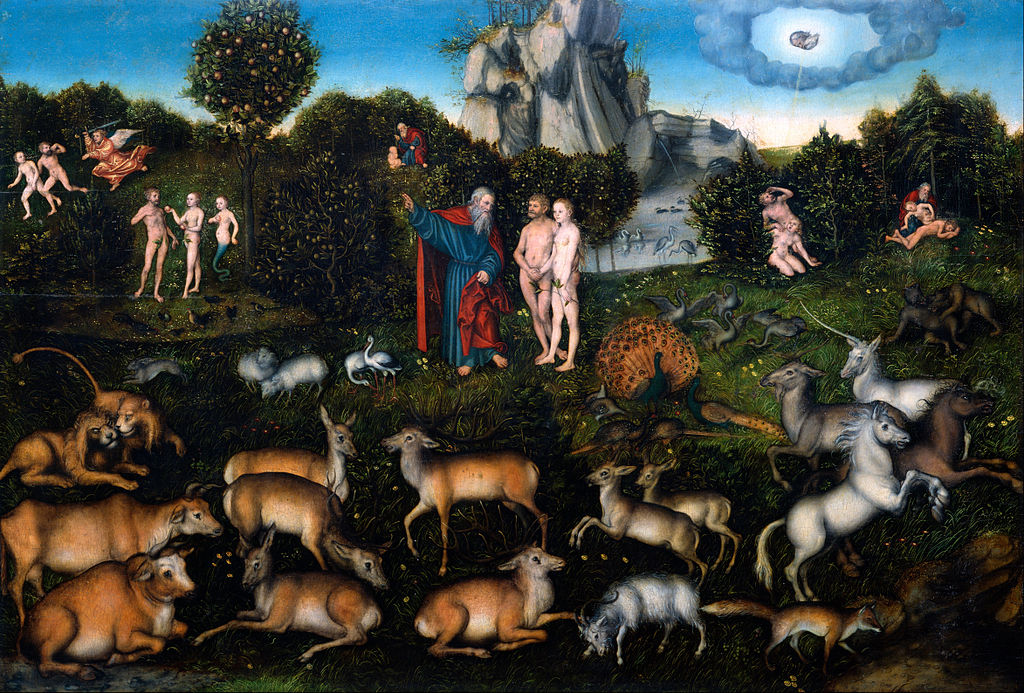As the minivan rolls toward the Garden of Eden, my first thought is: Huh. A few more gas stations and fast food restaurants than I imagined.
Neither of which would have seemed out-of-the-ordinary for a place like Galesville—a small town (population: 1,556) situated on the western edge of Wisconsin. We are en route to La Crosse, though made a pit stop along the way to take in the view. It is, indeed, a lovely landscape, one worthy of edenic comparisons. Yet for 19th century Methodist reverend David Van Slyke, Galesville didn’t just resemble the Garden of Eden, it was the Garden of Eden—a near perfect topographical match to the description set forth in Genesis.
Though the Bible offers no specific coordinates (hardly unexpected given that the entirety of the world’s creation was summed up in a few deft lines), it does offer a few clues for religious scholars to puzzle over. Such as the Bible’s mention of Eden’s location near the site of four rivers: the Pishon, the Gihon, the Tigris and the Euphrates. For many, these ancient waterways—two of which still flow throughout western Asia—would confirm Eden’s location in or around modern day Iraq, Syria and Kuwait. Yet Van Slyke had another theory, believing the four rivers referenced were, in fact, the Trempealeau, the Black, the La Crosse, and the Mississippi—thereby confirming Galesville, Wisconsin as Eden’s true locale.
A bit of a departure, I admit, from what I’d learned in Sunday school.
Reverend Van Slyke buoyed his theory further by noting Galesville’s high bluffs, believing them to have served as the original “hanging gardens” noted in Genesis, or at least the remnants of the wall once said to surround the garden. In his 1886 tract “Found at Last: The Veritable Garden of Eden” (a later printing of which I obtained while perusing a local antique store), he guides readers to the top of one of Galesville’s highest bluffs, then asks us to peer down at the lush valley that extends like “the very ideal of a garden.”
Of course, no Eden is complete without a serpent, and Van Slyke accounts for that as well. From atop that bluff, he reminds readers to “look out for snakes”, adding also that Trempealeau County “has been notable and notorious for rattlesnakes” for generations—just ask the Native Americans.
Okay, okay, I think. So Van Slyke accounts for the rivers, the hanging gardens, even the snakes. Where, then, is Galeville’s Tree of Knowledge?
As far as I can tell, Van Slyke never quite could account for the missing tree, though in lumber-loving Wisconsin, it’s easy to imagine its omission easily chalked up to a few swift swings from an ax. Admittedly, Van Slyke’s theory is hardly an airtight case. Nevertheless, it gives the people of Galesville something to ponder (not to mention something to emblazon on a postcard.)
While Eden is said to serve as the embodiment of earthly perfection, it’s easy to forget that it was also the sight of original sin—a point made in a 1986 article on Galesville’s “ties” to the Garden. Sure, all was well and good for a while, but then came that pesky serpent and apple, the combination of which was said to prompt the need for fig leaves and loin coverings forever after. Call it what you will—a story, a parable, or the gospel truth—there are lessons to be learned. And upon first learning of Van Slyke’s theory, I can’t help but wonder if he himself committed another sin upon his allegedly hallowed ground. If it was pride that ultimately drove him to boast so publicly about the splendor of the place that he called home.
As his tract progresses, Van Slyke’s tone transforms from theologian to tour guide, urging visitors to “Come and See!” the splendor that is Galesville, and challenging all pilgrims to find a more fitting and beautiful locale for the Garden. “If there is,” he writes, “we would like to see it”.
Make no mistake: despite his occasional foray into tourism rhetoric, Van Slyke believed fully in his claim. Which prompts me to wonder: Does everyone feel so loyal to his or her homeland? And if so, does that mean my former home of Fort Wayne, Indiana should be in the running for “real-life” Eden as well?
All geographic signs point to no.
For one, Fort Wayne is one river short of the four, and in terms of hanging gardens, well, I guess we’ll have to make due with the arboretum downtown. But Fort Wayne needn’t be the Promised Land in order to be the land I love. Isn’t it enough for a place to evoke beauty and wonder on its own terms, regardless of any Biblical stamp of approval? Faith—bigger than any one place—conforms to no coordinates, and thus, do we really need a map to know it?
For those who do, I refer you to Google Maps. Go ahead, type in “Garden of Eden.”
Trust me when I tell you that there was no quickest route.
Image: Lucas Cranach the Elder. “The Garden of Eden.” 1530. Oil on panel. Old Masters Picture Gallery, Dresden State Art Museums, Dresden.




